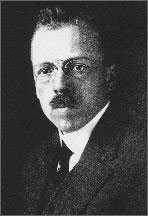ECS President | 1921-1947
 Colin Garfield Fink was born in Hoboken, New Jersey on December 31, 1881. After graduation from Columbia University in 1903, he went to Leipzig for graduate study. Here he received the Ph.D. degree with highest honors. Returning to America he joined the research staff of the General Electric Company. In 1917 Dr. Fink became chief chemist for the Chile Exploration Company and went from that position, in 1921, to Columbia where he became head of the Division of Electrochemistry. Following retirement from active teaching in 1950, he was appointed emeritus professor of chemical engineering.
Colin Garfield Fink was born in Hoboken, New Jersey on December 31, 1881. After graduation from Columbia University in 1903, he went to Leipzig for graduate study. Here he received the Ph.D. degree with highest honors. Returning to America he joined the research staff of the General Electric Company. In 1917 Dr. Fink became chief chemist for the Chile Exploration Company and went from that position, in 1921, to Columbia where he became head of the Division of Electrochemistry. Following retirement from active teaching in 1950, he was appointed emeritus professor of chemical engineering.
Dr. Fink joined The Electrochemical Society in 1907 and immediately became active in its affairs. He published many papers in the Transactions over the years. He was elected President of the Society and became Secretary upon the death of Joseph W. Richards in 1921. Upon retirement from the latter office in 1947, Dr Fink was made Secretary Emeritus of the Society.
The professional career of Dr. Fink was threefold: scientist, educator, and executive secretary-editor. Among his best-know research projects were those that led to ductile tungsten for incandescent lamp filaments, an insoluble anode for electrowinning copper, an electrolytic process for the faithful restoration of corroded ancient bronzes, the development of hot dipped aluminum coatings, the electrodeposition of metals, and in particular, a commercial process for chromium plating. He was the author of over 200 papers and help many patents.
Dr. Fink had the qualities of a great teacher. His infectious enthusiasm, insatiable curiosity, and energetic drive inspired all who came in touch with him. His students became leaders in science and engineering in America and overseas, both in academic and industrial circles.
Dr. Fink made an enormous contribution to The Electrochemical Society as Secretary for 26 years. He spent every moment spared from teaching and research on Society matters. He did correspondence, bookkeeping, financial reports, meeting arrangements, Board meetings, editorial work, translations, manuscript styling, and prepared a monthly Society Bulletin. Many believe he saved the Society from extinction in 1921 and during the great depression period of the early 1930’s with his tireless efforts to keep it going.
Among the many honors received by Dr. Fink were the Acheson Medal and Prize in 1933 (he donated the $1,000 to the Society’s Roeber Research Fund) and the Perkin Medal in 1934. He received an honorary D.Sc. degree and was elected Honorary Member of The Electrochemical Society in 1946.

